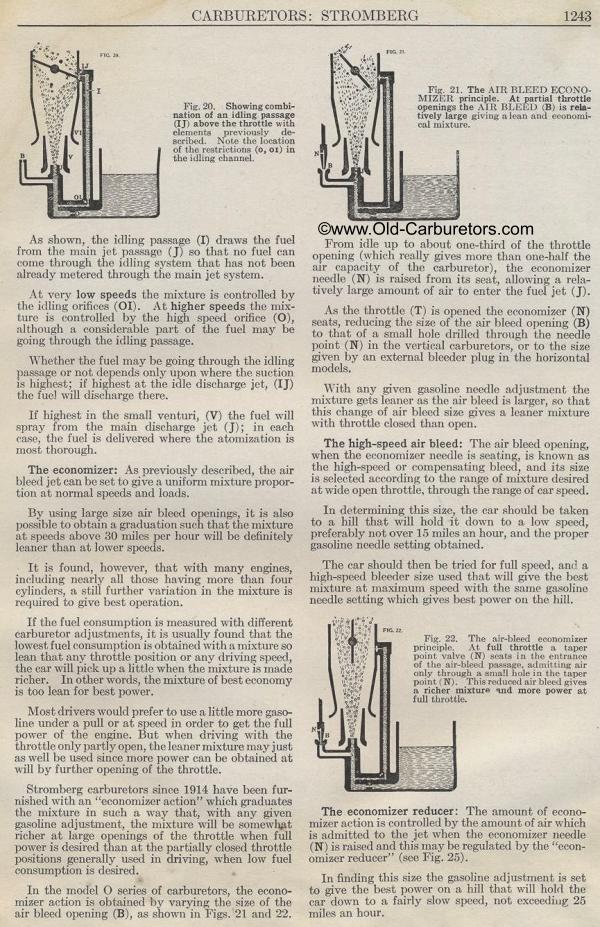STROMBERG
1 of the restrictions (o, or) in
Fig. 20. Showing combination of an idling passage (IJ) above the
throttle with elements previously de-scribed. Note the location
the idling channel.
Fig. 21. The AIR BLEED ECONOMIZLIt principle. At partial throttle
openings the AIR BLEED (B) is relatively large giving a lean and
economical mixture.
As shown, the idling passage (I) draws the fuel from the main jet
passage (J) so that no fuel can come through the idling system
that has not been already metered through the main jet system.
At very low speeds the mixture is controlled by the idling orifices
(0I). At higher speeds the mixture is controlled by the high speed
orifice (0), although a considerable part of the fuel may be going
through the idling passage.
hether the fuel may be going through the idling passage or not
depends only upon where the suction is highest; if highest at the
idle discharge jet, (IJ) the fuel will discharge there.
If highest in the small venturi, (V) the fuel will spray from the
main discharge jet (J); iii each case, the fuel is delivered where
the atomization is most thorough.
The economizer: As previously described, the air bleed jet can
be set to give a uniform mixture proportion at normal speeds and
loads.
By using large size air bleed openings, it is also possible to
obtain a graduation such that the mixture at speeds above 30 miles
per hour will be definitely leaner than at lower speeds.
It is found, however, that with many engines, including nearly
all those having more than four cylinders, a still further variation
in the mixture is required to give best operation.
If the fuel consumption is measured with different carburetor adjustments,
it is usually found that the lowest fuel consumption is obtained
with a mixture so lean that any throttle position or any driving
speed, the car will pick up a little when the mixture is made richer.
In other words, the mixture of best economy is too lean for best
power.
Most drivers would prefer to use a little more gasoline under
a pull or at speed in order to get the full power of the engine.
But where driving with the throttle only partly open, the leaner
mixture may just as well be used since more power can be obtained
at will by further opening of the throttle.
Stromberg carburetors since 1914 have been furnished with an "economizer
action" which graduates the mixture in such a way that, with
any given gasoline adjustment, the mixture will be somewhat richer
at large openings of the throttle when full power is desired than
at the partially closed throttle positions generally used in driving,
when low fuel consumption is desired.
In the model 0 series of carburetors, the economizer action is
obtained by varying the size of the air bleed opening (B), as shown
in Figs. 21 and 22.
From idle up to about one-third of the throttle opening (which
really gives more than one-half the air capacity of the carburetor),
the economizer needle (N) is raised from its seat, allowing a relatively
large amount of air to enter the fuel jet (J).
As the throttle (T) is opened the economizer (N) seats, reducing
the size of the air bleed opening (B) to that of a small hole drilled
through the needle point (N) in the vertical carburetors, or to
the size given by an external bleeder plug in the horizontal models.
With any given gasoline needle adjustment the mixture gets leaner
as the air bleed is larger, so that this change of air bleed size
gives a leaner mixture with throttle closed than open.
The high-speed air bleed: The air bleed opening, when the economizer
needle is seating, is known as the high-speed or compensating bleed,
and its size is selected according to the range of mixture desired
at wide open throttle, through the range of car speed.
In determining this size, the car should be taken to a hill that
will hold it down to a low speed, preferably not over 15 miles
an hour, and the proper gasoline needle setting obtained.
The car should then be tried for full speed, and a high-speed bleeder
size used that will give the best mixture at maximum speed with
the same gasoline needle setting which gives best power on the
hill.
Fig. 22. The air-bleed economizer principle. At full throttle a
taper point valve (N) seats in the entrance of the air-bleed passage,
admitting air only through a small hole in the taper point (N).
This reduced air bleed gives a richer mixture qnd more power at
full throttle.
The economizer reducer: The amount of economizer action is controlled
by the amount of air which is admitted to the jet when the economizer
needle (N) is raised and this may be regulated by the "economizer
reducer" (see Fig. 25).
In finding this size the gasoline adjustment is set to give the
best power on a hill that will hold the car down to a fairly slow
speed, not exceeding 25 miles an hour.
Previous page 1927
Supplement Home Next page 
|